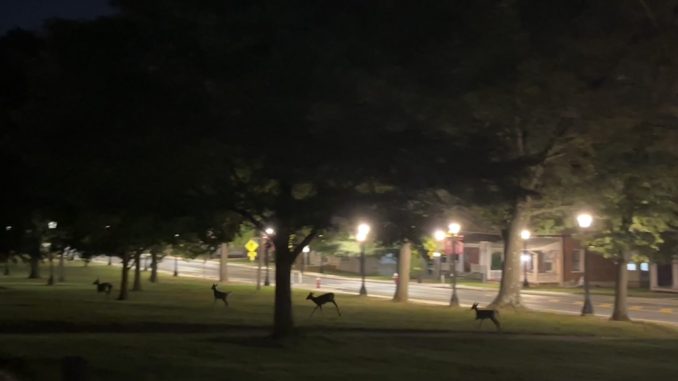
It’s past midnight; the campus is mostly dark besides the glow of the streetlamps and the lit-up dorm rooms of nocturnal students. You are walking back to your dorm after another late night spent studying and you feel as though everything is eerily still. No other students are walking around; the wind has ceased to breeze through the trees, and you appear to be the only creature moving through the night. Despite this, you feel that a presence is with you, but just out of sight. You almost don’t notice a dozen heads and the whites of their dopey eyes following each step you take. At first you return their stare, but it feels unsettling to look into their eyes, both knowing and empty. Not wanting to intimidate the deer, you avoid eye contact out of fear. These creatures of pity and innocence become mystical and threatening. Walking forward, you become self-conscious, and your steps quicken to make it past the herd. Finally, as if breaking out from a trance, one of the deer gallops off, signaling the others to collectively leap away. They got the information they needed from you and are reporting it back to the others.
You might think you scared these skittish creatures away. But these deer are no longer scared of us humans; they are growing rebellious.
The deer on this campus have a reputation for their fearlessness, and there are many circulating explanations as to why. Some say they are desensitized to humans because of how many students they encounter. Others say the deer are stuck at Ursinus College because they are blockaded by Main Street and First Avenue (the road along the Perkiomen Trail). I say the deer are plotting to take over Ursinus College. Like any good uprising, there will be signs.
The first sign is discontent. Deer have several reasons to be upset with Ursinus. For one, we have literally trapped them on our campus with an endless stream of cars driving up and down Main Street. While us main-streeters have the traffic button to press when we need to cross the road, these deer are not equipped with the dexterity to press such a button. So, they walk back and forth across our campus for all of their lives. When they do try to make their escape, our cars prevent them from doing so.
The next sign is sporadic rebellions. Clearly teenage deer, feeling angsty enough towards the system, are starting to make bolder statements, like jumping in front of cars and causing accidents. Other deers are more subtle, eating from our gardens, slowly overpopulating, and manipulating our ecosystems.
Finally, there is solidarity. These deer have been forced into proximity with one another, and rather than turning against one another, they have identified a common enemy: Ursinus students. They are tired of us overcrowding their plots of land and giving them constant anxiety. While they might be off-putting to us, imagine how uncomfortable they are as they watch these strange, clothed bipeds walk around leisurely from building to building.
To figure out what these deer are plotting in their newfound solidarity, I did a stake out by the Perkiomen Trail. Deer are crepuscular creatures, meaning they are most active at dawn and dusk, so around six, I waited for the deer to come to the trail that connects campus to Perkiomen. If you have ever taken a walk when the sun was going down, you are familiar with the deer that congregate in this area. At times, I have seen around thirty deer here, likely discussing their plans for uprising. But they must have sensed me with their rotating ears and wide eyes, because no congregation of deer occurred. I sat still for a while, but by the time darkness had settled, I accepted my failure before I became the deer’s first victim. These deer are evolving; they wouldn’t be so foolish as to let a reporter observe their meticulous plan.
The signs are clear, now it’s just a matter of how we respond. There is always deer repellent, but there’s also joining their side of the rebellion. If you see a deer walking on their hind legs, just know you’ve been warned.
